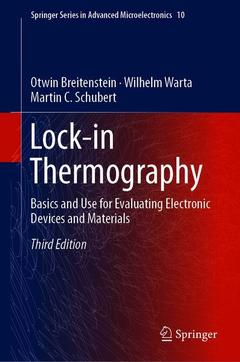Lock-in Thermography (3rd Ed., 3rd ed. 2018) Basics and Use for Evaluating Electronic Devices and Materials Springer Series in Advanced Microelectronics Series, Vol. 10
Auteurs : Breitenstein Otwin, Warta Wilhelm, Schubert Martin C.

1. Introduction
2. Physical and Technical Basics
2.1 IR Thermography Basics
2.2 The Lock-in Principle and its Digital Realization
2.3 Lock-in Thermography
2.4 Timing Strategies
2.5 Influence of Non-Harmonic Heating
2.6 Noise Analysis
2.7. Calibration
2.8 Heat Dissipation and Transport Mechanisms in Solar Cells
2.9 Carrier Density Imaging
3. Experimental Technique
3.1 Different (Lock-in) Thermography Realizations
3.2 Commercial Lock-in Thermography Systems
3.3 Illumination Systems
3.4 Solid Immersion Lenses
3.5. Realization of CDI/ILM Systems
3.5.1. Absorption Mode
3.5.2. Emission Mode
3.5.3. Lifetime Calibration
4. Theory
4.1 Influence of the Heat Conduction to the Surrounding
4.2 Temperature Drift Compensation
4.3 Thermal Waves of Point Sources
4.4 Thermal Waves of Extended Sources
4.5 The Quantitative Interpretation of Lock-in Thermograms
4.5.1 The Image Integration / Proportionality Method
4.5.2 Deconvolution of Lock-in Thermograms
5. Measurement Strategies
5.1 Which Signal Should be Displayed?
5.2 Influence of the Lock-in Frequency
5.3 Influence of the IR Emissivity
5.4 Influence of the Peltier Effect
6. Typical Applications
6.1 Integrated Circuits
6.1.1 3D Analysis
6.1.2 IC-Tester Controlled LIT
6.2 Solar Cells
6.2.1 Dark Lock-in Thermography (DLIT)
6.2.1.1 Shunt Imaging
6.2.1.2 High-current DLIT
6.2.1.3 Series Resistance Imaging (RESI)
6.2.1.4 Ideality Factor and Saturation Current Mapping
6.2.1.5 Local I-V curves measured Thermally (LIVT)
6.2.1.6 Reverse-bias DLIT
6.2.1.7 Temperature Coefficient and Slope Imaging
6.2.1.8 DLIT-based Jsc Imaging
6.2.1.9 Local I-V Evaluation
6.2.1.10 LIT and Luminescence Imaging: Comprehensive Loss Analysis
6.2.2 Illuminated Lock-in Thermography (ILIT)
6.2.2.1 Voc-ILIT
6.2.2.2 Jsc-ILIT
6.2.2.3 Rs-ILIT
6.2.2.4 Avalanche Multiplication Factor Imaging (MF-ILIT)
6.2.2.5 ILIT-Based Efficiency Imaging
6.2.2.6 ILIT-Based Jsc Imaging
6.2.2.7 Suns ILIT
6.2.3 Summary of Solar Cell Applications
6.3 Failure Analysis of Solar Modules
6.3.1 Differential ILIT Techniques
6.3.2 Solar Cell Analysis in Modules (SCAM)
6.4 Spin Caloritronics
6.5 CDI/ILM on Solar Materials
6.5.1 Analysis of Material Evaluation During Processing
6.5.1 Temperature-Dependent Measurements
6.5.3 Trap Density Images from CDI/ILM
7. Summary and Outlook
References
Appendix: Thermal and IR Properties of Selected Materials
List of Symbols
Abbreviations
Index
Dr. Otwin Breitenstein received his Ph.D. in physics from University of Leipzig (Germany) in 1980 with a work on Deep Level Transient Spectroscopy (DLTS). Since 1992 he is with Max Planck Institute of Microstructure Physics, Halle, Germany, where he investigates defects in semiconductors. Since 1999 he has been using lock-in thermography, optical imaging methods, and electron microscopy, for characterizing crystalline solar cells. He is mainly interested in detecting internal shunts and generally evaluating the local efficiency of inhomogeneous silicon solar cells. He is Assistant Professor at University of Halle, Germany, giving lectures on the physics of solar cells and on advanced characterization techniques. He is author of several hundred publications in journals and at conferences and author of a book on "Lock-in Thermography" (Springer 2003, second edition 2010).
Dr. Wilhelm Warta received the Diploma and Ph.D. degrees in physics from the University of Stuttgart, Germany, in 1978 and 1985, respectively. He joined Fraunhofer Institute for Solar Energy Systems, Freiburg, Germany, in 1985, in recent years he acted as Head of the Department Characterization and Simulation/CalLab and the Deputy Director of the Division Silicon Solar Cells—Development and Characterization. He is the author or coauthor of close to 400 papers in reviewed journals and conferences. His research interests include the development of characterization techniques and application to crystalline silicon materials and solar cells, silicon material properties, and the impact on solar cell performance, simulation of solar cells, and cell processing, as well as solar cell calibration with highest precision.
Describes an imaging technique for the evaluation of materials and electronic devices
Discusses various new application fields of lock-in thermography
Is useful as a reference work for researchers and engineers alike
Includes extensive comparison to Photoluminescence Imaging
Date de parution : 01-2019
Ouvrage de 321 p.
15.5x23.5 cm


